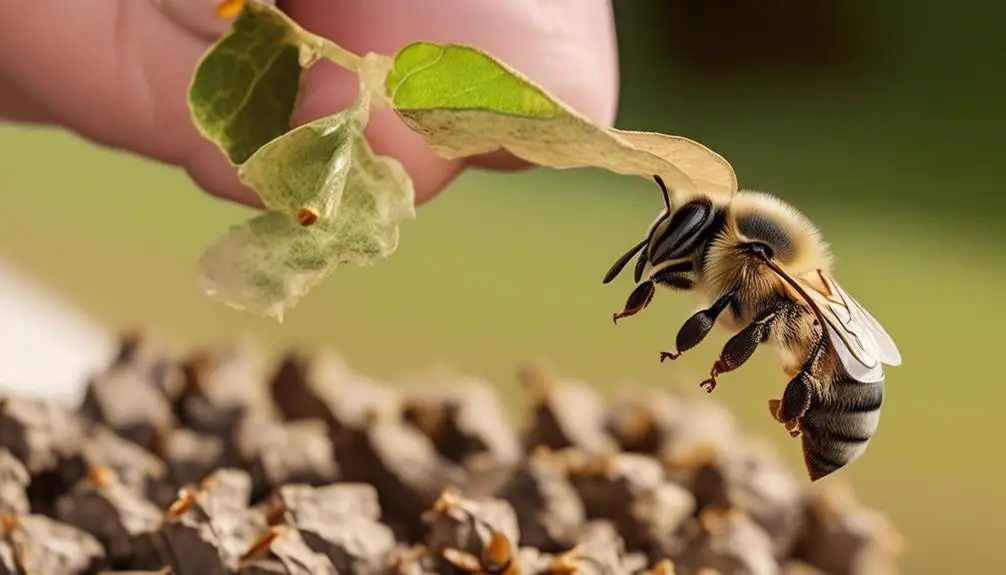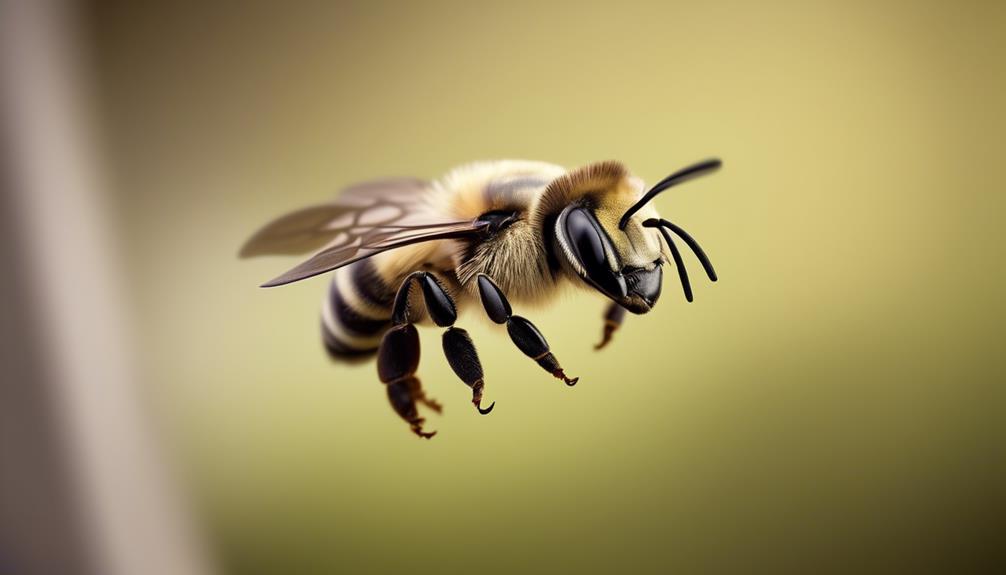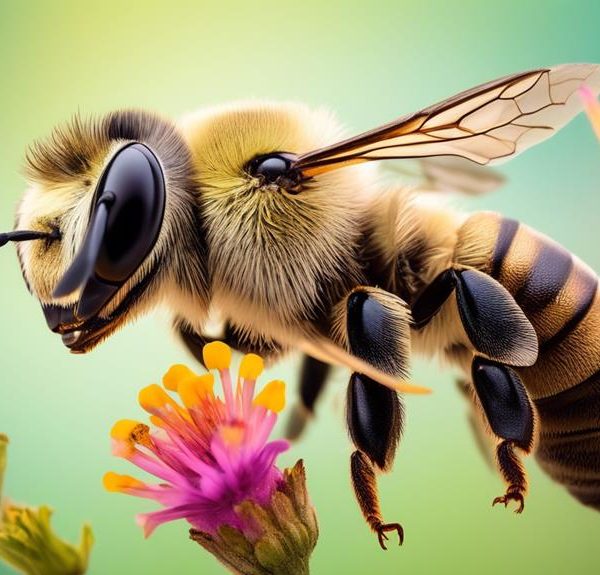Journey into the intriguing world of leaf cutter bees and discover if their sting is a threat to you.

Do Leaf Cutter Bees Sting You
Have you ever wondered if leaf cutter bees pose a threat with their sting? You've likely seen these industrious insects buzzing around your garden, slicing neat circles out of your plants' leaves.
While this behavior might lead you to believe they're harmful, it's important to remember that not all bees are created equal. Like other bee species, leaf cutter bees have the ability to sting, but how often and under what circumstances they choose to exercise this defense mechanism might surprise you.
Stick around as we explore the fascinating world of these misunderstood creatures.
Key Takeaways
- Leaf Cutter Bees are solitary and docile creatures that rarely sting unless threatened or handled roughly.
- The sting of a Leaf Cutter Bee is much less painful compared to a wasp or honey bee sting, often described as a mild pinch.
- Allergic reactions to Leaf Cutter Bee stings are rare but can occur in some individuals.
- Leaf Cutter Bees are essential to the ecosystem as effective pollinators, contributing significantly to the success of crops and the growth of plants.
Understanding Leaf Cutter Bees

While you mightn't be familiar with Leaf Cutter Bees, they're truly remarkable creatures worth understanding due to their unique behaviors and notable contributions to our ecosystem. You'll find these bees particularly fascinating, as unlike many other bees, they don't construct their nests from wax, but rather from leaf fragments. They're highly skilled architects, using their sharp mandibles to cut perfect circles from leaves, which they then carry back to their nest in a spectacle that's often mistaken for a flying leaf.
But they aren't just architectural marvels. Leaf Cutter Bees also play a critical role in pollination. They're solitary bees and female leaf cutters are quite industrious, making multiple trips to collect pollen and nectar, inadvertently spreading pollen as they go. This makes them extremely effective pollinators, much more so than honeybees.
Now, you might be wondering about their sting. In truth, Leaf Cutter Bees are docile creatures. They'll rarely sting unless threatened or handled roughly. Even then, their sting is mild compared to other bees. Understanding these exceptional bees helps us appreciate their positive impact on our environment and the delicate balance of our ecosystem.
Behavior and Characteristics

Delving into the behavior and characteristics of Leaf Cutter Bees, you'll soon discover their intriguingly complex and highly organized lifestyles. These solitary bees are known for their unique leaf cutting behavior. They use their powerful jaws to cut perfectly circular or oval pieces from plant leaves, which they then carry back to their nests.
Unlike honeybees that live in large colonies, Leaf Cutter Bees typically live alone. Each female constructs her own nest, usually in soft, rotted wood or in the hollow stems of plants. The leaf pieces that they cut are used to line these nests, forming a protective barrier for their eggs.
Leaf Cutter Bees are also highly efficient pollinators. They carry pollen on the underside of their abdomen, allowing them to pollinate flowers as they travel from plant to plant collecting leaves. This behavior makes them vital for the health of ecosystems and agriculture.
In terms of aggression, Leaf Cutter Bees are typically quite docile. They're more interested in plants than people, and while the females do possess a sting, they're unlikely to use it unless directly threatened. So, while they can sting, the risk is minimal and their benefits as pollinators far outweigh any potential danger.
Leaf Cutter Bees and Humans

Despite their solitary lifestyles, Leaf Cutter Bees play an integral role in human existence, particularly in terms of ecosystem health and agricultural productivity. As efficient pollinators, they contribute significantly to the success of our crops. Their unique method of pollination, known as 'buzz pollination,' is especially beneficial for plants like tomatoes, peppers, and blueberries.
However, your interactions with these insects aren't always positive. You may notice circular cutouts in your plants' leaves, a telltale sign of a Leaf Cutter Bee's presence. Don't be quick to consider them pests though. These bees rarely cause significant damage to healthy plants, and their pollination benefits often outweigh the aesthetic harm they cause.
In terms of safety, Leaf Cutter Bees are typically non-aggressive and only sting when threatened. Their stings are less painful than a honey bee's, but you should still exercise caution, especially if you're allergic to bee stings. Their presence in your garden should be welcomed, as they're a sign of a healthy ecosystem. By understanding their behavior and importance, you can coexist peacefully with these beneficial insects.
The Sting of Leaf Cutter Bees

Building on the notion of safety, let's examine the actual sting of a Leaf Cutter Bee, something that might concern those spending time in their gardens. Yes, Leaf Cutter Bees can sting, but it's crucial to understand that they're not naturally aggressive. They'll only resort to stinging if they feel threatened or are handled roughly.
The female Leaf Cutter Bee does have a stinger, a modified ovipositor that delivers venom. However, compared to a sting from a wasp or a honey bee, a sting from a Leaf Cutter Bee is much less painful. It's often described as a mild pinch, akin to the snap of a tiny rubber band. There's minimal swelling and the discomfort dissipates quickly.
Now, you might be wondering about allergic reactions. It's rare, but some individuals may experience an allergic response to a Leaf Cutter Bee sting. Symptoms can include localized swelling, redness, and itching, and in very rare cases, anaphylaxis. If you notice severe symptoms, seek immediate medical attention.
Managing Leaf Cutter Bees Safely

Regularly interacting with Leaf Cutter Bees in your garden requires a careful approach to ensure both your safety and their preservation. These bees are essential to the ecosystem, aiding in pollination and promoting plant growth. However, their presence doesn't mean you can't enjoy your garden. You can manage these bees safely by understanding their habits and behaviors.
Leaf Cutter Bees are solitary creatures. They're not aggressive and will only sting if threatened or handled directly. Thus, it's crucial to avoid disturbing their nests. They typically nest in plant stems or wood, making holes that are easy to spot. If you find such a nest, don't panic or attempt to remove it. Instead, let the bees carry on with their business.
Furthermore, consider wearing protective clothing when gardening. Although their sting is mild, some people may have allergic reactions. Gloves and long-sleeved shirts can provide a necessary barrier.
Lastly, if you're particularly concerned, you can hire a professional beekeeper or pest control service to manage the bees.
Conclusion
In conclusion, you shouldn't fear leaf cutter bees. Yes, they can sting, but they're generally non-aggressive and will only do so if threatened.
Their ecological role is crucial, helping in the pollination process.
So, if you spot these bees around, don't panic. Instead, appreciate their contribution to our environment.
Remember, managing them safely and responsibly is the key. Knowledge is power, so understand and respect these fascinating tiny creatures.


